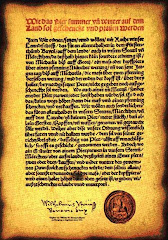
As I said in my first post on wine technology, there is an ongoing discussion of wine technology and tradition; and now a new factor is in play-so-called truth in labeling laws and regulations. As we continue in the series, many issues will be addressed; for now we’ll talk about how wine ages and techniques traditionelle and techniques moderne.
Texture, taste, color, and sediment deposits are factors in red wine ageing. Pigmented tannins, combinations of tannins and anthocyanins, provide mouthfeel, texture, and color in red wines. These components, called phenolics, are produced, or rather extracted or leeched, when the wine grapes are pressed. Early on the chemical reactions are based on these pheloics’ reactions with acid in the wine. As the wine ages, either in cask or bottle, these reactions are influenced by the presence of oxygen introduced into the wine when pressed, transferred, racked, or bottled. As time goes by, good title for a song, huh?, these different chemicals come together, agglomerate, and eventually get too heavy to stay in suspension in the wine. Hence, we have sediments, changes in color, and changes in taste. This why a fifteen year old fine Bordeaux needs decanting: the sediments are the harsher components of the wine that have dropped out, producing a wine with more integrated flavors, a harmonious texture, mouthfeel, and a slightly brown tinged color from the deep purple where the wine started when it was born.
The traditional method for ageing red wines is in the cask with added time in the bottle, sometimes for decades with potential for a great wine to achieve a century mark. Or more.
Based on the results of this ageing process, if like and kind results can be achieved in a fraction of the time, should modern techniques be used to achieve the desired result? Winemakers have available methods for filtering solids to remove bitter components from the wine. Oak flavor and nuance can be achieved by using oak staves, chips, and, some say, oak saw dust. By a process of micro-oxygenation, winemakers can hasten chemical processes that used to take months or years. This is where a wine is saturated with micron size molecules of oxygen, which filter through the wine to replicate the more traditional ageing in barrels.
Ageing can also be hastened by storage at higher temperatures than in traditional cellars. Again, cellaring was to hold wines at a constant temperature to allow the ageing process to occur. If you cellar your wines for five years, and I micro-oxygenate my wines and store at a higher temperature for one year, and we have almost the same result, is one process authentic and the other dishonest? Is one method old fashioned and the other making use of sound wine making technology?
If I use modern technology, should I be required to say this on my wine label? For example: “This wine was micro-oxygenated for six days, thirteen hours, seven minutes and four seconds before being aged in non-reactive vats with oak staves five cm thick, two meters long, and in a paddle array of five staves for three months, two days, five hours and six minutes?” You get the idea.
If aged traditionally, whatever that means, should producers be required to say like and kind describing in minute detail their processes and cellar environments?
These are not easy questions.











